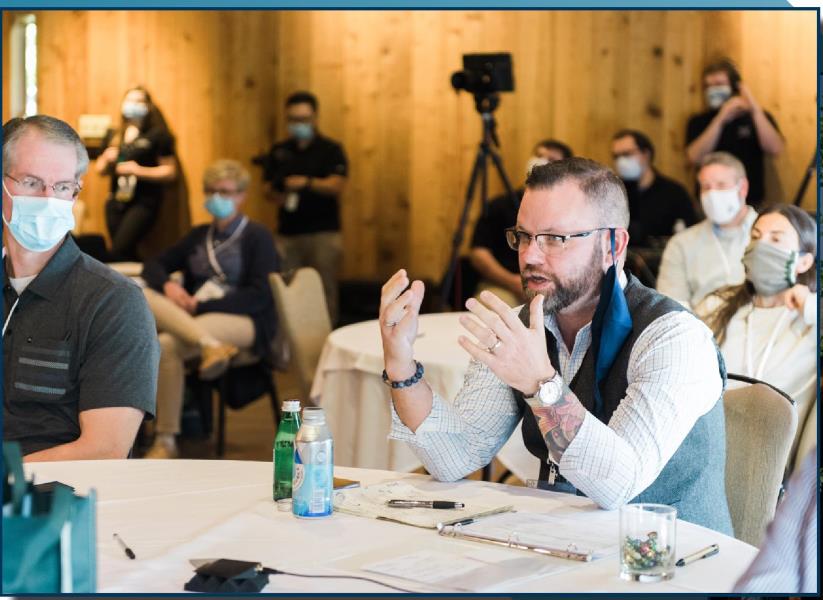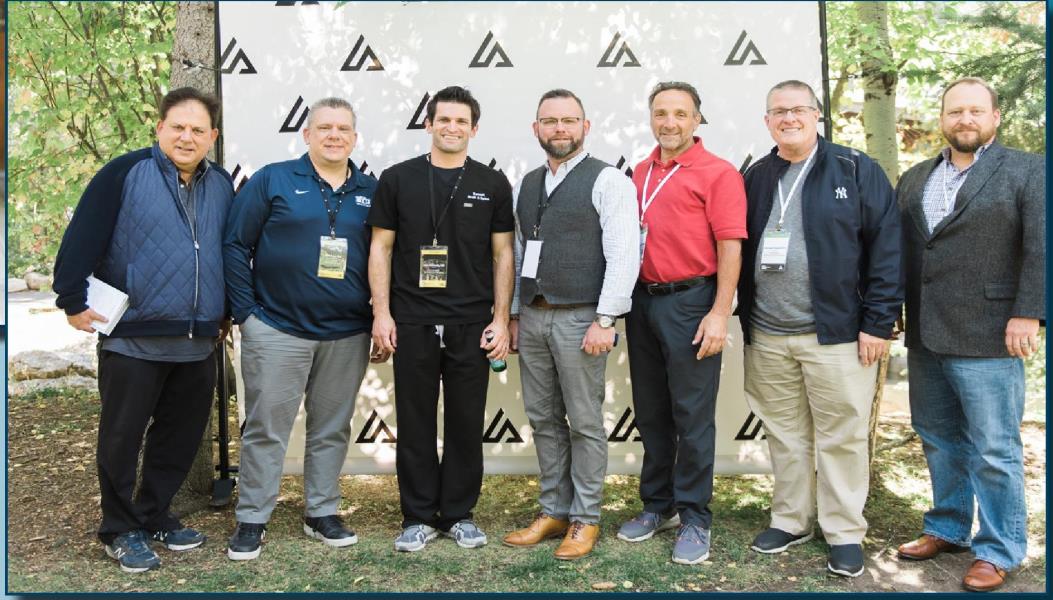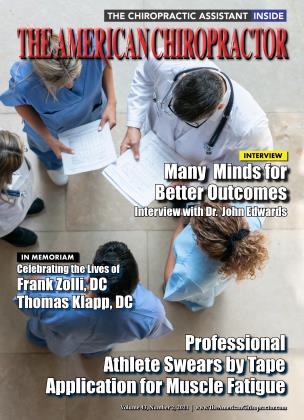Including the Fellowship Trained Chiropractor as Spine Management Physician Benefits Patients and Enhances Efficiency
February 1 2021 Dr. William OwensIncluding the Fellowship Trained Chiropractor as Spine Management Physician Benefits Patients and Enhances Efficiency
February 1 2021 Dr. William OwensInterview with Neurosurgeon Dr. John Edwards
by Dr. William Owens
Dr. Edwards attended Brigham Young University where he received a bachelor's degree in microbiology in 2005. Then he attended the University of Iowa Carver College of Medicine, where he received his medical degree in 2009. Dr. Edward attended his neurosurgical residency in neurosurgery at Indiana University, graduating in 2015. He performed over 2,000 surgeries in his residency. I was exposed to a high volume and broad spectrum of cranial, spinal, and peripheral nerve surgery.
I'm Dr. William Owens (W.O.), Director of the National Spine Management Group, and I recently sat down with Dr. John Edwards (J.E.), Neurosurgeon to discuss his experience with chiropractic care in his practice in the Utah Valley. Over the last several years, Dr. Edwards has worked closely with chiropractors in his community to provide optimal management to the patients that require diagnosis and triage. He thought the best way to articulate his interaction with the chiropractic profession was to share real-life events and examples. I want to thank Dr. Edwards for his time and dedication to spine care.
Read on, in this exclusive conversation between Dr. John Edwards and William Owens.
J.E.: Thank you, I am looking forward to sharing my experiences with the chiropractic profession. I would also like to thank The American Chiropractor for being gracious enough to give me a platform to tell my story. I attended Brigham Young University where I received a bachelor's degree in microbiology in 2005. I then attended the University of Iowa Carver College of Medicine, where I received my MD degree in 2009. My residency in neurosurgery was at Indiana University. At the time, the neurosurgery group there was one of the busiest in the country with over 7,000 cases per year. I performed over 2,000 surgeries in residency. I was exposed to a high volume and broad spectrum of cranial, spinal, and peripheral nerve surgery. I graduated Residency in 2015.
W.O.: That is a significant level of training and I think you sharing that helps the chiropractic profession to understand how much training a neurosurgeon undergoes to ensure they are proficient. I would like to talk about what your recent accomplishments are as well. Can you tell us more about what you’ve been up to this past fall? I think readers will be interested.
J.E.: Yes, of course, I am excited to share that. Recently, we held the first-ever Spine Management Summit in September 2020, where we invited over 100 healthcare professionals to sit down together and participate in a wide range of case-based discussions. Mark Pope, the head basketball coach at Brigham Young University, was invited to give the keynote address. He talked about teamwork, referencing a play in the last minute of the 1997 NBA finals between the Utah Jazz and the Chicago Bulls. The score was tied when the Bulls called timeout. The coach set up a play with Michael Jordan taking the shot. But as they walked back onto the court, Jordan told teammate Steve Kerr, “If Stockton double-teams me, I’m going to you.” And that’s exactly what happened. Stockton moved in, and Jordan passed the ball to a wide-open Kerr, who drained the shot to put the Bulls ahead and seal the championship.
 Left: Dr. Richard Jackson (Neuroradiologist) Right: Dr. William Owens
Left: Dr. Richard Jackson (Neuroradiologist) Right: Dr. William Owens
You might wonder what that story had to do with our conference. The answer is it had everything to do with our conference. We believe in teamwork - not just on the court, but in the healthcare professions as well. We believe that many minds lead to better outcomes, and so, unlike other medical conferences, we invited neurosurgeons, chiropractors, physical therapists, pain doctors, clinical psychologists, pharmacologists, and more to sit down at the same table and learn from each. We did this over a three-day period by discussing cases in an open forum.
W.O.: The talk by Mark Pope was so inspirational and I actually remember that championship game, I was living in Chicago at the time. One question I would have for you outside of the details of the conference, would be how you got from starting practice to this type of interprofessional conference? The feedback after the event was stunning, most providers commented they had never been to a conference like that before. I felt the same, being one of the groups of chiropractors at the conference.
J.E.: That was a significant result of the conference and one that inspires me to continue to reach out and build relationships. I began formulating the idea of a different approach to spine care a few years ago when I had only been in practice for a few months. It started one night when I received a phone call from the emergency department. They had a female patient with excruciating back pain, they wanted me to take a look at her. When I got there, the patient was kneeling on the cold floor next to her bed. She was kneeling because it was the only position that provided some relief from her pain. I discovered that she had been under the care of a chiropractor for six months, but his treatments had failed, and her pain had become unbearable. She came to the emergency room because she didn’t know where else to turn. Although I was well-trained in neurosurgery during my residency in Indiana, performing over 2000 surgeries and being exposed to a high volume environment, I knew very little about chiropractic, except that they were occasionally improperly blamed for vertebral artery dissections. I now know there is no causal link based on the published literature.
I sent the patient for an MRI, which had not previously been ordered, and it showed a severe disc herniation. In retrospect, this patient would have been better served had a root-cause analysis been done much earlier. I did surgery on her later that day, and she walked out of the hospital the following morning without pain. Hers was a fairly routine case for me, and yet, when I look back on it, it was the beginning of something extraordinary. That particular case made me wonder how practitioners could do a better job of communicating with each other so their patients could get relief faster. That exact question was still on my mind a few weeks later when a patient named Julie came into my clinic. She had also been working with a chiropractor, and she also had a severe disc herniation.
 Left to Right: Dr. Larry Lefcort, Dr. Eric Lee, Dr. John Edwards, Dr. William Owens, Dr. Ron Salvaggione, Dr. Don Capoferri, and Dr. Scott Ferguson
Left to Right: Dr. Larry Lefcort, Dr. Eric Lee, Dr. John Edwards, Dr. William Owens, Dr. Ron Salvaggione, Dr. Don Capoferri, and Dr. Scott Ferguson
But there was one big difference. Rather than coming on her own, Julie was referred by a local chiropractor, Dr. Eric Lee, who had completed a thorough workup, including an MRI, and could see that surgery was indicated. Julie told me she was afraid of surgery because she worked in a spine surgeon’s office, and she didn’t see patients getting better. Instead, she saw patients with chronic pain who returned every month to renew their opioid prescriptions. Some even returned a few years later for a second or third surgery. Neither of those scenarios was acceptable to her, however, Dr. Lee convinced Julie to see me for a consultation, reassuring her that a good neurosurgeon could help her beyond anything he could do at this point. Dr. Lee also discussed that he would be available to help her prepare for the surgery, and recover afterward.
This was new to me. I’d never seen a chiropractor do such a thorough workup, and since I knew almost nothing about his field, I didn’t understand how he could help Julie both before and after surgery. I picked up the phone, as I often do, and called Dr. Lee’s office. He and I met for lunch the next week. It didn’t take long for me to realize that Dr. Lee knew what he was talking about and he had a significant level of post-graduate training. He was extremely well-versed in spine pathology and MRI spine interpretation. He had significant advanced CE training and was currently working to complete a Fellowship in Spinal Biomechanics Trauma, he has since completed that Fellowship training.
I asked him, “Why did you send Julie to me? You don’t even know me.” His answer surprised me. It wasn’t because of my training or my patient outcomes. It was because he had heard I might be willing to collaborate with other doctors. He replied, “If more neurosurgeons were open to collaborating with chiropractors, we could really help more patients.” I wanted to learn more about how we could accomplish that very thing. That lunch was the first of literally hundreds of conversations with Dr. Lee. We talked about how prevalent back pain is, how we believe it has fueled the opioid crisis, and how, despite pouring billions of dollars into treating it year after year, we haven’t made a lot of progress. Mostly, we talked about how we could work together to help patients.
"We should all keep in mind, all markets are built on a currency, and the currency of the medical community is trust."
W.O.: That is really a great story and it clearly changed your mindset. I thought it was interesting how little exposure chiropractic and neurosurgery get to each other. We need to work together to make this more common across the country. I know you have some deep feelings about interprofessional care, can you share some of that with the readers as well?
J.E.: Yes, of course. Let me address this from a big picture perspective and then get a little more detailed. Like other areas of the human body, the anatomy of the back is extremely complex, and since patient problems are also complex, and we can’t expect to solve them with a unilateral approach [one siloed practitioner doing only the procedures he/she knows how to do]. Instead, we should be leveraging many providers for the benefit of the patient. That’s where the title of this interview comes from, Many Minds for Better Outcomes. Over time, I began talking to other chiropractors in my area, including the McCleans - Gordon, and his sons, Devin and Matt. I learned that they were working on the same Fellowship training as Dr. Lee. One of the core program requirements was to shadow many different physicians, including observing a neurosurgeon both in the clinic and in the operating room. I invited them to come with me so I could learn from them as well. That exposure helped me to begin discussing more cases with Dr. Lee and the McCleans. I learned from them and I think they learned from me. We recognized that by working together, we could help patients more effectively than if we were treating them, which ultimately made us all busier.
W.O.: That is a great point about learning from each other, the healthcare community needs more of this. Do you have any particular example of how that process you just described actually translated into helping a specific patient?
J.E.: I think that I have a really wonderful example. This type of collaboration was never more obvious than in the case of Emy. Emy came into the clinic having been in serious pain for several months, bouncing back and forth between a dozen different practitioners, but with no success. Emy’s pain was affecting every part of her life - not the least of which was taking care of her five children. I felt the only way for Emy to find real relief was to get to the root cause of her problem, so I sent her to Dr. Lee, who practices as a Spine Management Physician. I told Emy what I had discovered about Dr. Lee, that his advanced training made him one of the best spine diagnosticians in the area, and if anyone could help us get to the root cause of her symptoms, he could, and he did. He first took some alternate-position images of Emy’s spine. Then he and I along with Richard Jackson, a local neuroradiologist, discussed them together. We discovered that Emy had Bertolotti’s Syndrome, which had been exacerbated by a car accident. Because of that diagnosis, our understanding of the cause of her pain and why she had failed other treatments allowed us to help her in a very specific way. Within a few weeks, she had her life back.
W.O.: I believe that is one of the larger trends in healthcare today, is having the skilled spine diagnostician working to help coordinate care. It seems the personal experiences had motivated you to do more, can you explain?
J.E.: In a desire to expand the collaboration, I began holding quarterly dinners, inviting people from many different disciplines to come and discuss cases together. We frequently had 60 or 70 in attendance. After dinner, they would stay and exchange phone numbers. I realized that although they were in the same community, they had never met each other. There had never been a forum to do that. This was the beginning of collaborative, interdisciplinary care in our community. We should all keep in mind, all markets are built on a currency, and the currency of the medical community is trust. As we spent time together, held dinners, and collaborated more and more, we developed a high degree of trust, learning to value what each discipline could offer to each patient which ultimately helps us to communicate better.
In October 2019, I decided to form my own neurosurgical practice and asked my father to help me run it. In the spirit of collaboration, we began holding Weekly Grand Rounds and inviting a variety of caregivers to discuss each case. The Weekly Grand Rounds became more and more popular, providers really enjoyed working together. I saw that there was a greater need in the community at large and we decided to host an official conference at the Sundance Resort in Utah this past September. That is the fast-track explanation of how the Spine Management Summit 2020 was born.
W.O.: I really like hearing about the evolution of professional relationships. It seems when you put the patient first and find a group of caring providers, there is a lot you can do to increase your reputation and patient outcomes. We are about out of time, however in closing can you talk briefly about the Summit and how we can make that content available to readers to get the Grand Rounds started in their own communities?
J.E.: Sure, we had a remarkable experience there, discussing cases with the wisdom of some of the best healthcare minds in our area. We videotaped every session and all the discussions so other practitioners could have a seat at the table, even if they were not there.
Like many other chiropractors, Eric, Devin, and Matt struggled to find a way to work with a neurosurgeon. We are trying to make that easier and assist the chiropractic profession in building community-based spine care relationships. One of the reasons we are doing this is through our videotaped conference sessions and Weekly Grand Rounds. These are now available at www.spinemanagementsummit.com. This will help the Chiropractic profession to learn HOW to structure case discussion and get started in their own community. My hope is that our ongoing weekly Summit Rounds and our Spine Management Summit 2021 will spark the development of collaboration and teamwork among spine providers around the country.
W.O.: Dr. Edwards, I want to thank you for your time and your dedication to changing the delivery of spine care in our country and eventually the world.
J.E.: Thank you... this is all a lot of fun.
Dr. Owens is now the Director of the National Spine Management Group, LLC whose overall mission is the creation and management of research-based continuing education and practical data-driven, evidenced-based, practice consulting services for chiropractors seeking to increase personal injury referrals in their community. NSMG's programming works in partnership with the Federation of Chiropractic Licensing Boards, Cleveland University Kansas City, College of Chiropractic, and the State University of New York at Buffalo, Jacobs School of Medicine and Biomedical Sciences. Dr. Owens can be reached at 716-228-3847 or [email protected]
 View Full Issue
View Full Issue






